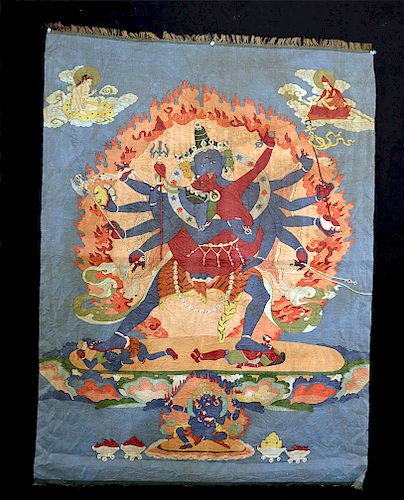19th C. Tibetan Silk Thangka - Chakrasamvara in Yab-Yum
Lot 112
About Seller
Artemis Gallery
686 S Taylor Ave, Ste 106
Louisville, CO 80027
United States
Selling antiquities, ancient and ethnographic art online since 1993, Artemis Gallery specializes in Classical Antiquities (Egyptian, Greek, Roman, Near Eastern), Asian, Pre-Columbian, African / Tribal / Oceanographic art. Our extensive inventory includes pottery, stone, metal, wood, glass and textil...Read more
Estimate:
$5,000 - $7,000
Absentee vs Live bid
Two ways to bid:
- Leave a max absentee bid and the platform will bid on your behalf up to your maximum bid during the live auction.
- Bid live during the auction and your bids will be submitted real-time to the auctioneer.
Bid Increments
| Price | Bid Increment |
|---|---|
| $0 | $25 |
| $300 | $50 |
| $1,000 | $100 |
| $2,000 | $250 |
| $5,000 | $500 |
| $10,000 | $1,000 |
| $20,000 | $2,500 |
| $50,000 | $5,000 |
| $100,000 | $10,000 |
| $200,000 | $20,000 |
About Auction
By Artemis Gallery
May 10, 2018
Set Reminder
2018-05-10 10:00:00
2018-05-10 10:00:00
America/New_York
Bidsquare
Bidsquare : Fine Ethnographic / Asian / Ancient Art
https://www.bidsquare.com/auctions/artemis-gallery/fine-ethnographic-asian-ancient-art-3213
Featuring antiquities from around the world including Pre-Columbian, Tribal, Classical, Asian, so much more! Artemis Gallery info@artemisgallery.com
Featuring antiquities from around the world including Pre-Columbian, Tribal, Classical, Asian, so much more! Artemis Gallery info@artemisgallery.com
- Lot Description
Central Asia, Tibet, ca. late 19th to early 20th century CE. Created using the highly-specialized Kesi-slit tapestry technique, this beautiful polychrome silk thangka portrays the fierce guardian deity Chakrasamvara in tantric yab-yum with the female deity Vajravarahi. Chakrasamvara is presented in the characteristic Vajrayana Buddhist style having twelve arms, three heads, and wearing a tiger skin. He also clenches a flayed elephant skin behind his back and wears a drooping garland of shells, all the while standing in front of a fiery nimbus. Below the entwined deities is an expressive Heruka which wields a lengthy sword in one hand and a trident in the other. A single arhat is seen in the upper left-hand corner, and a worshipper is shown in the upper righthand corner. Noteworthy is the extensive use of gold-wrapped silk threads which are woven into the design to enliven the diadem crowns, jewelry, vajras, and other fine details. An excellent example of the Kesi-slit tapestry technique. Size: 30" W x 40" H (76.2 cm x 101.6 cm).
Yab-yum, literally meaning "man-woman," is the portrayal of the tantric sexual embrace between male and female divinities and represents the pacification of spiritual polarities. Thangka expert Ben Meulenbeld also explains that yab-yum is a "non-orgasmic action that is meant to express the elimination of duality" (Buddhist Symbolism in Tibetan Thangkas . . , p. 73).
The Kesi-slit stitch process is an extremely fine and time-consuming woven loom technique. Kesi, or K'o-ssu in traditional Chinese, focuses on having each colored area be woven from a separate bobbin. The horizontal weft was then linked to the next colored bobbin and then continued. On a 45 degree angle, the links are evenly distributed along the mutual border of two different areas of color. But the closer to vertical the thread lines get, the further apart the links between the colors becomes. Thus, by its very nature, the weaving technique displays vertical 'slits' (Kesi-slit tapestry). The backside of a Kesi-slit tapestry is always the same as the front side only reversed, and the entirety of the design is two-dimensional. This technique is practiced primarily because of its lightweight construction and the clarity of the patterns.
For further information, see: Meulenbeld, Ben. Buddhist Symbolism in Tibetan Thangkas: The Story of Siddhartha and Other Buddhas Interpreted in Modern Nepalese Painting. Havelte, Holland: Binkey Kok Publications, 2004. Print.
Provenance: private Bricker Collection, USA
All items legal to buy/sell under U.S. Statute covering cultural patrimony Code 2600, CHAPTER 14, and are guaranteed to be as described or your money back.
A Certificate of Authenticity will accompany all winning bids.
We ship worldwide and handle all shipping in-house for your convenience.
#124143Minor wear and fraying along peripheries; a few loose threads on the main composition (primarily on nimbus and deity bodies), and minor staining that does not disturb the imagery. Creasing throughout due commensurate with age and due to the nature of silk. Several vertical slits are noticeable but are a characteristic resulting from the stitch technique, and not of superficial or age-related wear. Overall very good condition and vibrant imagery.Condition
- Shipping Info
-
All shipping is handled in-house for your convenience. Your invoice from Artemis Gallery will include shipping calculation instructions. If in doubt, please inquire BEFORE bidding for estimated shipping costs for individual items.
-
- Buyer's Premium



 EUR
EUR CAD
CAD AUD
AUD GBP
GBP MXN
MXN HKD
HKD CNY
CNY MYR
MYR SEK
SEK SGD
SGD CHF
CHF THB
THB
















